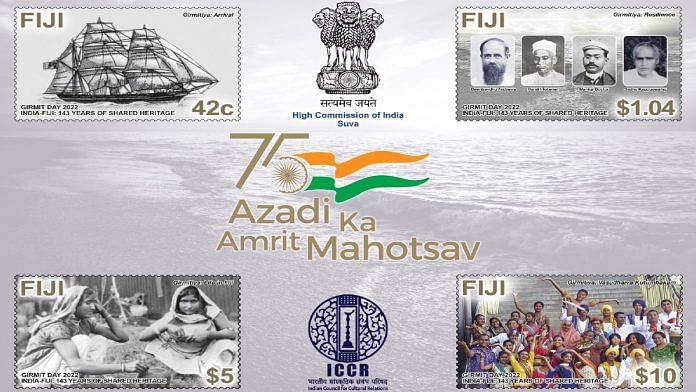New Delhi: The Indian diaspora, the largest in the world, is spread across countries like the US, Canada, UK and UAE, but few know of the history of ethnic Indians in girmitiya countries.
Between the early 19th and early 20th centuries, more than a million indentured Indian labourers, or ‘girmitiyas’, were transported from British India to work on plantations in 19 British colonies. Fiji, Mauritius, Jamaica, South Africa, Guyana and Suriname are among the many girmitiya countries that are home to large ethnic Indian populations.
Fiji Hindi, the first language of children born on such plantations, was one of the many byproducts of this phenomenon.
On 3 August, the Parliamentary Standing Committee on External Affairs said that the external affairs ministry has written to the education ministry to introduce the history of girmitiyas in school education in India.
The panel also said it would try to conduct more events to promote interaction between India and girmitiya countries, and would propose to establish a “Girmitiya university/faculty/chair”.
This comes 10 months after the first-ever ‘Girmitiya Conference’ was organised virtually by India, and presided over by Minister of State for External Affairs V. Muraleedharan. Participants from 18 countries deliberated on the contributions and successes of girmitiyas across the world, and the obstacles faced by them.
India has two popular schemes which help girmitiyas reconnect with their Indian roots — the Pravasi Teerth Darshan Yojana (PTDY), which offers the elderly sponsored pilgrimage tours across India, and the Know India Programme (KIP), which has been in existence since 2003 and offers 21-day tours to youth of Indian origin.
ThePrint explains the history of the girmitiyas and how they were transported from British India.
Also read: Singapore defends employing workers from India & other countries as opposition seeks limits
Who are girmitiyas?
The word ‘girmitiya’ is etymologically derived from ‘girmit’, meaning ‘agreement’. Indians then pronounced ‘agreement’ as ‘girmit’, so indentured labourers who were transported to work in places like Fiji and Mauritius, became known as ‘girmitiyas’. However, the agreements weren’t all that fair.
Indian labourers signed indentureship contracts with the British in hopes of higher wages and better employment opportunities. However, they made long treacherous journeys on old slave ships and upon reaching foreign lands, were made to live in slave barracks, were paid very little, and did not have access to proper legal frameworks under which they could get grievances redressed.
As linguist Farzana Gounder explains in her 2011 book Indentured Identities, in order to fulfil the legal requirements of indenture contracts, the British were compelled to put in place a mediator between plantation authorities and girmitiyas. However, the overseers typically sided with the plantation authorities and complaints often went unheard.
“Moreover, in making complaints, girmitiyas risked increasing these authorities’ infliction of abuse,” wrote Gounder.
Were girmitiyas slaves?
Though girmitiyas were not technically slaves in the eyes of the law, they were subjected to a practice known as “blackbirding”, which involved deceiving or tricking people to work as slaves or poorly paid labourers in countries far away from their native land.
In her 2018 book Not Quite Not White, Sharmila Sen, editorial director at the Harvard University Press, pointed out that such practices came about after the British outlawed slavery in the 1830s and there were fears that a “labour vacuum” would affect the production of sugar.
“Vast profits were to be made from Caribbean sugar in the 19th century and many wealthy British families were involved in the business. As newly freed Afro-Creole slaves moved from the plantations to cities, the British started looking for alternate sources of labour,” Sen wrote.
She added that after a brief experimentation with populations such as Scots, Lebanese, Syrians and others, it was decided that villagers recruited from the Indo-Gangetic plains were the best bet.
Despite the unfortunate history of girmitiyas, their descendants have prospered in their respective countries, some having held “high-level” government positions and others having achieved success in business and arts. For example, V.S. Naipaul, a Trinidadian-British writer of Indian descent, won the 2001 Nobel Prize for Literature. His grandfather was a sugar plantation worker on the island of Trinidad.
India has been working with countries like Fiji to increase awareness about the history of girmitiyas.
On 14 May this year, as part of ‘Azadi Ka Amrit Mahotsav’ celebrating 75 years of India’s independence, the Indian High Commission in Fiji released a set of postage stamps to mark the 143rd ‘Girmit Day’ and the arrival of indentured labourers from India to the Pacific island.
(Edited by Nida Fatima Siddiqui)
Also read: Govt firm’s ‘incompetence’ delaying migrant workers & employment surveys, says expert panel head



